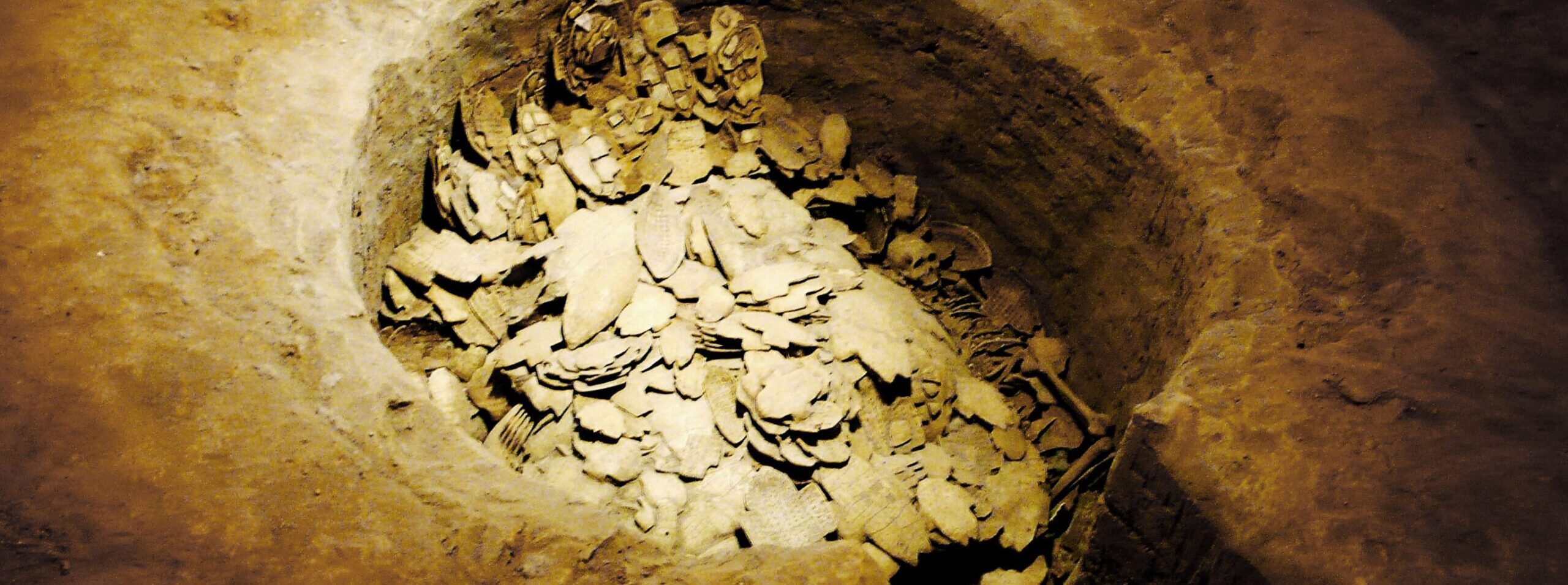The discovery of the “Dragon bones”
To understand what are these bones, we will go over the history of its discovery in the beginning of the 20th century.

Wang Yirong
In 1899 the Chancellor of the Imperial Academy, Wang Yirong (1845-1900), became sick with malaria. He asked his doctor for medicine and was sent to an apothecary for the best-known remedy: dragon bones. This medicine was supposed to be made from the ancient bones of dragons and had mystical properties for healing.
“Dragon bones” were an expensive but not uncommon remedy in Beijing pharmacies. They were prescribed in powdered form, but on this occasion, the scholar Wang Yirong acquired a piece of a whole bone. The piece was a real bone, though it had several strange markings on its surface.

Wang, along with his friend Liu E (劉鶚, 1857-1909), recognized the inscriptions as ancient writing and began investigating with sellers to obtain more whole pieces. This was not an easy task. The access to the bones was often denied by the pharmacists, who preferred to keep the origin of their medicine a secret.
Unveiling the Oracle Bones
In 1903, after Wang Yirong had passed away, Liu E published the first book with prints of these inscriptions from the bone fragments he had managed to find. These bones became sought after by collectors, and a strong trade of these fragments emerged.
The “dragon bones” were finally revealed for what they are, which was, sadly, not made from dragons.
They were actually scapulae of oxen and turtle shells with human inscriptions. They were now called oracle bones (甲骨文 (jiǎgǔwén, ‘shell and bone script’)

It was only in 1908 that the origin of these bones was discovered.
They came from near the village of Xiaotun (小屯) in the Anyang region (安阳市), where thousands of fragments were found. At the time, there was much controversy regarding the authenticity of the discovery, and there may have been many forgeries due to the trade in these bones.

Reconstruction of Yinxu site
In 1928, two decades later, the Chinese Academy of Sciences began scientific excavations in the region and confirmed that Anyang was the capital of the Shang dynasty and that the bones dated to the same period. The place is called Yinxu (殷墟; ‘Ruins of Yin’) and it’s an archeological site anyone can visit today.
The Shang dynasty lasted about 600 years (approximately 1600-1046 BCE), directly preceding the Zhou dynasty under King Wen.

Yinxu – The Cradle of Chinese Writing
Reading the inscriptions
The inscriptions are some of the earliest manifestations of the Chinese language, and many characters show up for the first time carved on these bones. Some were hunting trips records or war documents, but most of them were oracle documents, that is, records of divination.
In Shang China, a bone or shell, having been carefully sown to shape, was burnished on the obverse and had hollows chiselled out on the reverse. […] The application of heat to the hollows on the reverse produced characteristic ├ shaped cracks on the obverse; this is the origin of the Chinese character bu 卜 (‘to make divination’). The diviner interpreted the cracks as the answer to his questions, which were engraved on the polished surface alongside the cracks. Some inscriptions were also colored in with red pigment

These divinations were carried out at the court of the Shang kings, and many of the questions were about military ventures, agriculture, or journeys and partnerships. In addition, there are records of dates, meteorological and astrological information, including one of the earliest accounts of a solar eclipse.


The study of the oracle bones script is called Oraculology. These writings are the earliest documents of written Chinese and the origin of many Chinese pictograms.

The discovery of these bones reveals that divination in China dates back much further than previously evidenced. The records of divination would reappear throughout Chinese history in a structure similar to that found on the bones: containing the date of the consultation, sometimes the name of the consultant, the content of the “question,” the prognosis of the diviner, and sometimes a subsequent account updating the oracle on its efficacy.
The oracle “dragon” bones are fascinating fragments of history which, much like the Book of Changes, the Yijing itself, offers insight into early divination practices in equal measure that it leaves us wondering, surrounded by enigmas.





